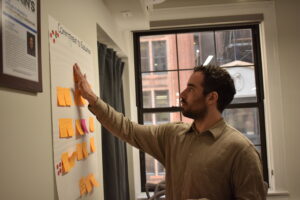Very few events can slow the breakneck pace of life in New York City like a heavy snowfall. As many of us experienced this weekend, a winter storm leads New Yorkers to stay at home, holed up and waiting for spring. Even in the absence of a blizzard, people are inclined to spend more time in their homes in the winter and that’s been amplified by the ongoing pandemic. For community-oriented organizations, businesses, or agencies looking to get input from community stakeholders on a project or program, this can pose a challenge. With fewer people spending time outside, gathering feedback from community members can prove quite tricky. Community engagement is essential to ensure projects and programs are equitable and maximize community impact. It doesn’t make sense to pause exciting development projects or innovative community programming just because it’s cold out, right?
Right. Or… maybe not. Equitable community engagement is a pillar of our work at Public Works Partners. In our experience, in-person engagement such as focus groups or one-on-one conversations are the gold standard for collecting helpful feedback from community stakeholders. Nearly every project we undertake involves some form of one-on-one or group-based engagement with community members. In the winter, fewer people are out and about and this leads to challenges in getting equitable, inclusive feedback from community engagement.
In-person engagement is not the only way to collect equitable stakeholder feedback, but it is the most reliable strategy. As the pandemic has created more opportunities for virtual engagement, connecting with community members without in-person engagement is more accessible than ever, but some barriers remain. According to a recent report by the New York State Comptroller, over 30% of New Yorkers making less than $20,000 and nearly 25% of all residents over 65 did not have internet access. Therefore, while revolutionary in its potential, virtual-only engagement is still likely to underrepresent elderly groups and other traditionally-marginalized populations. Thus, winter-based engagement cannot simply rely on virtual spaces to gain stakeholder feedback. Options like phone-interviews or phone-based surveys, carefully chosen tabling locations, and door-to-door outreach are good alternatives to virtual engagement that can still work in the winter.
One of the keys to inclusive engagement that Public Works Partners regularly emphasizes is to embed the engagement within the community: community block parties, markets, fairs, free concerts, or other public events are great ways to engage a broader segment of the community. In the winter, there are simply fewer events and almost none are taking place outdoors. This means embedded engagement opportunities are tough to come by. These challenges add up to make winter engagement an oft-frustrating endeavor. A project Public Works undertook three years ago taught us many lessons about winter engagement, hopefully our experience can teach you something as well.
Public Works Partners was engaged by The New York City Housing Authority (NYCHA) in 2018-19 to collect resident feedback on waste disposal in their developments to support the development of the NYCHA 2.0 Waste Management Plan. NYCHA requested that engagement take place between December and March. One morning, we held a focus group at a community center near a housing development in the South Bronx. It was 11 degrees out and four people showed up. About a week later, our team set up a table on a freezing afternoon outside a development in the lower east side. Over the course of two hours, we spoke with less than 10 residents and gained very little useful feedback. While it’s impossible to know exactly why these engagement methods failed, the weather clearly played a part in limiting our ability to connect with residents.
However, during this same project, there were some very successful methods of engagement. One snowy morning, our team set up a table inside a food pantry located in Ravenswood Houses in Queens. Over the course of nearly 3.5 hours, about a foot of snow came down and our team was effectively snowed-in inside the development. Because it was a warm food pantry with free coffee available to residents, people continued to flow in and out despite the snow. Our team spoke with nearly 150 different residents that day. We also distributed a survey through tenant associations, local organizations, and other community groups. Residents responded to the survey in droves. Over a two week period, we collected over 1,000 responses from a wide range of demographic groups.
As our team continued to struggle connecting with residents one-on-one using traditional methods, we turned to phone interviews with residents to collect feedback from particular demographic groups underrepresented in our other data collection efforts. Since people were staying home anyways, we were able to conduct over 100 phone interviews mostly with older folks which effectively made up for the lack of engagement in other efforts.
The project underscored one of the fundamental challenges of winter engagement: People simply don’t want to be outside. But, by adapting our strategy and meeting residents where they were, we were able to collect comprehensive stakeholder feedback data and provide a useful report to NYCHA.
One of the biggest adjustments we didn’t make in the project was that we never sent anything via mail. However, we did work with outreach workers recruited through a community-based organization to collect survey responses by knocking on residents’ doors. Through this outreach we collected hundreds of responses that we likely would never have received in a virtual-only outreach effort. The drawback of this strategy: many residents were not home, as the outreach was conducted during business hours. Mail–particularly sending surveys with prepaid return envelopes to residents–would likely have allowed us to reach an even larger segment of the resident population.
Winter outreach is a challenge, and as an organization we attempt whenever possible to schedule outreach in the summer months. However, when the timeline isn’t flexible, winter outreach is certainly doable, it just requires a more inclusive and strategic approach. To learn more about ensuring inclusive engagement, check out our article published on the subject here. Happy winter, New York!
[author] [author_image timthumb=’on’]https://www.publicworkspartners.com/wp-content/uploads/2019/02/SimonRosenblumLarson-2019.jpg[/author_image] [author_info]Simon assists client services by developing outreach strategies, supporting project management, and collecting and analyzing data. He also aids business development by drafting and copy-editing proposals.[/author_info] [/author]




 Public Works Partners is a WBE/DBE-certified urban planning and consulting firm. Our expertise lies in creating innovative, equitable, and sustainable solutions to complex problems.
Public Works Partners is a WBE/DBE-certified urban planning and consulting firm. Our expertise lies in creating innovative, equitable, and sustainable solutions to complex problems.